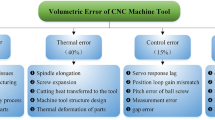Abstract
In this paper, the parallel and normal cutting forces on the tip of the tool are examined when altering a number of parameters in peripheral milling. The parameters studied are rake angle, chip thickness and upward/downward milling. The evaluation of the forces has been performed during cutting of the chip and the variation in the forces has been recorded. In this way, important information can be obtained in order to arrive at cutting data and tool geometries that will reduce surface defects such as torn and raised grain. In the past, very few investigations have been carried out on peripheral milling, probably because of the difficulties of measurement. Nowadays, however, new measuring techniques and equipment make it possible to measure cutting forces even in standard milling machines. In this work, a sensor was placed under the workpiece to measure the forces in three directions at frequencies up to 7000 Hz. To obtain detailed data, a plastic material was used so that the cutting (revolution) speed could be kept at a minimum, thereby maximizing the number of readouts per incision. The results show how the normal force (the force component perpendicular to the workpiece) varies during the cut and how it is dependent on the examined parameters. This force changes from negative to positive during the cut. When altering the machining parameters, the normal force changes in both direction and magnitude. The other force component, the parallel force, also shows a dependence on the parameters. The objective of this research is to find parameters that minimize the normal forces in order to avoid damage to the wood.
Zusammenfassung
Parallele und Normal-Schnittkräfte, die auf die Werkzeugspitze einwirken, wurden untersucht, wobei eine Reihe von Parametern bei der maschinellen Holzbearbeitung variiert wurden. Dies betrifft Neigungswinkel, Spandicke, Aufwärts- und Abwärts-Schneiden. Das Abschätzen der Kräfte geschah während des Schneidens, wobei die Veränderung der Kräfte aufgezeichnet wurde. So können wichtige Informationen zu Schnittdaten und Werkzeuggeometrie gewonnen werden, um Oberflächendefekte wie Ausreißen oder Aufstellen von Fasern zu verringern. Bisher liegen wegen der Schwierigkeit beim Messen nur wenige Untersuchungen zu diesem Thema vor. Heute ist es mit neuen Meßtechniken möglich, die Schnittkräfte auch an Standardmaschinen zu messen. Ein Sensor wurde unter dem Werkstück angebracht, um die Kräfte in drei Richtungen bei Frequenzen bis zu 7000 Hz zu messen. Um detaillierte Werte zu erhalten, wurde ein Plastikmaterial verwendet, so daß die Schnittgeschwindigkeit minimiert und dadurch die Datenpunkte pro Einschnitt maximiert werden konnte. Die Ergebnisse zeigen, wie die Normalkraft während des Schneidens variiert, und wie sie von den untersuchten Parametern abhängt. Diese Kraft ändert sich von negativen zu positiven Werten während des Schneidens. Bei Änderung der Parameter ändert die Normalkraft sowohl die Richtung als auch die Größe. Die andere, parallele, Kraftkomponente zeigt ebenfalls eine Abhängigkeit von den Parametern. Ziel der Arbeit ist es, Parameter zu finden, die die Normalkräfte minimieren und so Schäden am Holz zu vermeiden.













Similar content being viewed by others
Notes
Manufactured by ATI Industrial Systems, Garner, NC (http://www.ati-ia.com).
References
Axelsson BOM, Lundberg ÅS, Grönlund JA (1993) Studies of the main cutting force at and near a cutting edge. Holz Roh- Werkstoff 51:42–48
Box GEP, Hunter WG, Hunter JS (1978) Statistics for experimenters. John Wiley & Sons, New York, pp 306–344
Engin S, Altintas Y, Ben Amara F (1999) Mechanics of routing medium density fiberboard. Proceeding of the 14th International Wood Machining Seminar, Epinal, France, 12–19 September 1999
Huang Y (1994a) Cutting force components in orthogonal cutting parallel to the grain (90-0) 1—Effects of the rake angles. Mokuzai Gakkaishi 40(10):1134–1140
Huang Y (1994b) Cutting force components in orthogonal cutting parallel to the grain (90-0) 2—Effects of feed lengths. Mokuzai Gakkaishi 40(10):1059–1066
Kivimaa E (1950) Cutting force in wood working. Publication No.18. The State Institute for Technical Research, Helsinki, Finland
McKenzie WM (1961) Fundamental analysis of the wood-cutting process. University of Michigan, Ann Arbor, Michigan
McKenzie WM, Franz NC (1964) Basic aspects of inclined or oblique wood cutting. Forest Prod J 14(12):555–566
McKenzie WM, Ko P, Cvitkovic R, Ringler M (1999) Towards a model predicting cutting forces and surface quality in routing layered boards. Proceedings of the 14th International Wood Machining Seminar, Epinal, France, 12–19 September 1999
Palmqvist J, Johansson G (1999) Cutting forces in peripheral milling of wood. Proceedings of the 14th International Wood Machining Seminar, Epinal, France, 12–19 September 1999
Scholz F, Hoffman W (1999) Cutting force measurement and practical application. Proceedings of the 14th International Wood Machining Seminar, Epinal, France, 12–19 September 1999
Stewart HA (1983) A model for predicting wood failure with respect to grain angle in orthogonal cutting. Wood Fiber Sci 15(4):317–325
Stewart HA (1991) Importance of clearance angles particularly with small rake angles. Forest Prod J 41(10):73–75
Acknowledgement
This research was financed by the Foundation for Knowledge and Competence Development (the KK Foundation), the Association for Swedish Wood Products Research (Träforsk) and the Swedish foundation “Ansgariusstiftelsen”.
Author information
Authors and Affiliations
Corresponding author
Rights and permissions
About this article
Cite this article
Palmqvist, J. Parallel and normal cutting forces in peripheral milling of wood. Holz Roh Werkst 61, 409–415 (2003). https://doi.org/10.1007/s00107-003-0427-0
Published:
Issue Date:
DOI: https://doi.org/10.1007/s00107-003-0427-0




